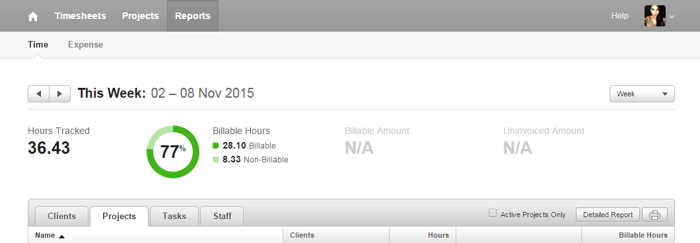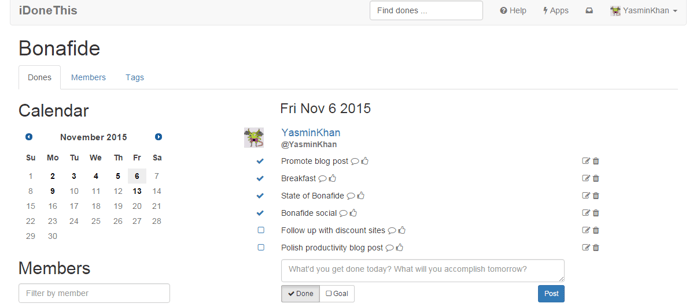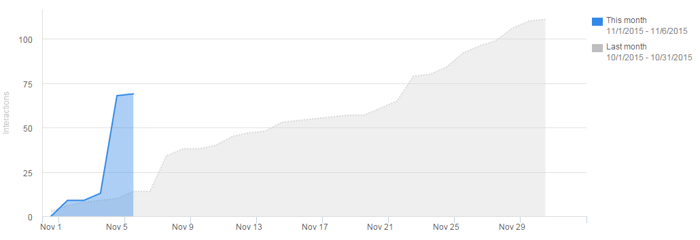
We live in an entrepreneurial time, where productivity, efficiency, and working from home are not only ideals and goals, but they’re crucial to business’ success. Gone are the days of riding the time clock just to log 40 hours a week at your 9-5 job. The idea of showing up and simply putting in the time isn’t enough anymore! These days, what you get done and the results you produce are far more important and valuable to the team than someone who spends all day on a single task, in between their personal phone calls, extended breaks, and fantasy footballing.
Ever see this? No more.

The truth is – there’s always work that needs to be done. The work is never finished. The clients are never satisfied. We always feel as though we could be doing more. Employees, supervisors, and entrepreneurs alike are empowered to take initiative and do whatever they think will help further the business.
With time being such a precious commodity, we wanted to make sure we were spending our workweek in a way that was best for our business. As is the case in any company, but especially in a small one like ours, each and every employee is capable of having a significant impact on the bottom line and the culture of the company. We took a lot of care to put together a diversified team of talented individuals who (seem to) like working together, so we didn’t want to squander our resources!
Also, it’s worth mentioning that we recently rebranded our company. We went from Zizinya Web Solutions to Bonafide, and anyone who has ever taken on such an undertaking will tell you – it’s a lot of work. We went from being busy to being extra busy. Productivity was the name of game, and we had to find ways to master it quickly.
Naturally, we came up with a few things that really seemed to boost our company’s productivity. These practices got us through the rebranding process, and they continue to help us as we grow.
Tasks Completed versus Time Spent
The main thing that helped us reclaim our work days was time-tracking. We primarily did this using the Harvest app, and once we started, the value was undeniable. Our employees were suddenly accountable for where they were spending their time. We were able to organize our day by task and by client, as opposed to just huge 8-hour blocks of vague “work.”
We have always expected at least 40 hours of work a week from our employees, but now, those 40 hours are well-spent. After all, what’s the point in clocking 40 hours when you’ve got nothing to show for your time? Employees don’t like wasting their time, and employers don’t like thinking about those opportunity costs. Once we started time-tracking, 40 productive hours came naturally. We were able to literally see where time was being wasted, which allowed us to reallocate our time more effectively. More tasks were being completed in a timely manner, and our clients were getting the most out of their retainers.
Work-From-Home Wednesdays
Sometimes, you’ve just got to get out of the office, hunker down, and get to work. People definitely work differently in an office than they do at home or in a coffee shop, so we implemented an initiative called Work-From-Home Wednesdays. The name is pretty self-explanatory, but it’s enough to make some managers squirm. At Bonafide, we felt that due to the nature of our work, the nature of our employees, and our ability to hold each other accountable for where we were spending our time, we could make it work. Not to mention, our employees love it.
There are a few reasons why this has worked out well for us, but a large part of the program’s success is due to our ability to track our time. We can still hold ourselves accountable for our time and ensure that we are still being productive, even outside of the office. By using IDoneThis, in conjunction with Harvest, we can see what our coworkers are working on throughout the day. We’re able to leverage our resources and technology in a way that allows us to stay connected with one another without being intrusive.
Reverse-Engineering
Sometimes, even without specific goals in place, good things happen. For example, maybe you noticed that your social reach on Twitter has been growing exponentially compared to other social platforms, and you want to know why. By going back through time records, you can see whether or not employees have spent extra time nurturing Twitter leads. Maybe several employees were actively working with Twitter, unbeknownst to each other, and the extra manpower actually led to some tangible results.
With a little detective work, you can learn what works from experience, rather than from trial-and-error. The next step is to just duplicate your results!

Manage Deadlines
It can be tricky to keep yourself on task all the time, but when you’ve got a deadline approaching, you’ve got to make sure your time is being spent in the right places. At Bonafide, we use Teamwork to help us stay on task and on time, and to communicate our plans-of-action with our clients. Typically, we start with a time budget for each client, and as tasks come up, we give them an estimate as to how long that task is expected to take. By creating deadlines for ourselves and making ourselves accountable to our clients, we can ensure that tasks are being completed in a timely manner, and things aren’t constantly being pushed to the backburner. It also gives our clients peace of mind knowing that their business’ needs are being tended to.
We now keep track of the time we spend on a specific task, even if we jump around to other tasks throughout the day. If we notice that we haven’t put in the expected amount of time on a particular task, we can adjust our schedules throughout the day to make sure that we meet our deadlines.
Set Goals for the Day
In the morning when we get into the office, we plan our day out by setting the timers that we know we’ll be using in Harvest. This acts as a to-do list, and it also makes it easier for us to start and end a task. We can see what needs to get done, and we can make sure that none of those timers are still at 0:00 by the time we leave for the day. Of course, as other tasks come up throughout the day, we just add a new timer.
Something that seems to help in time budgeting is to leave yourself a note on each timer with how much time you want to spend on the task. Once the task is complete and the timer is stopped, you can then go back and update the note with what was done within the time you actually spent on the task.
Embrace the Creative Process
Some tasks are easier to time-manage than others. More tedious tasks may be boring, but they are fairly predictable as far as how long they’ll take. Still, content creation of any kind will take some time, and how much time they take is really anyone’s guess. What if your writer’s blocked? What if your graphic designer is obsessing over a few pixels? What if there’s an enormous amount of background research that needs to be done before your social media manager can “grasp” the marketing message? Historical data does little to help predict time allocation on such tasks, so the best you can do is just keep track of the time that’s actually put in.
As an inbound marketing agency, a lot of what we do requires some legwork and creative license. Time-tracking has helped us here by calling attention to time-wasting and procrastination as they happen. If we notice that we’ve spent an hour on a task and made no progress, we know it’s time to put that task aside, try something else, and then revisit it once we’ve got a fresh perspective and fresh set of eyes.
Do Weekly Self-Audits
After a week of diligent time-tracking, goal setting, and task-completing, it’s good to take inventory of the time that actually passed and where it went. It’s easy to get a false sense of accomplishment as you go through the day-to-day grind, but the numbers don’t lie. Good resource allocation allows you to analyze the hours you spend down to the details. By looking into the time spent over the course of a week, you can reassess your time management as you go. For example, if you notice that one client is eating up more of your time than they’re paying for, you can nip it in the bud, rather than let it continue to inflate over the course of a few weeks. By doing this, you’re not only using your time more wisely, but you’re using the company’s resources in a manner that is mutually beneficial to you and your clients.
These practices have helped our company grow and evolve from the SEO company we once were to the full-blown inbound marketing agency we are today. We continue to learn from our own habits as we expand our business, and at this point – there’s no going back. What was life before time-tracking? We can’t really remember, but it sounds like it sucked.
Photo Sean MacEntee | Used under Creative Commons image attribution license 2.0
